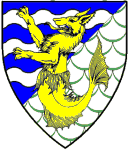| View previous topic :: View next topic |
| Author |
Message |
sketchrbob
Joined: 20 Mar 2005
Posts: 30
City/Region: Belfast
State or Province: ME
Vessel Name: Robert Witherill
|
 Posted: Thu Oct 20, 2011 11:55 am Post subject: How Do You Install Your Own Compass? Posted: Thu Oct 20, 2011 11:55 am Post subject: How Do You Install Your Own Compass? |
 |
|
To start, select a trial location for your compass. Sit in the helmsman's seat and try the compass in different locations. You should be able to see it easily. If you want to locate it in the center of the boat -- this may be a good location to get it away from magnetic interference-- you can use 45° lubber lines. (See post on "How to Make a Good Compass Better". Once you have selected your trial location tape it down with masking tape. Try to align the lubber line with the bow of the boat but it does not have to be perfect as we will correct that during the adjustment process. Do not drill any holes at this time. The wiring for the compass light will be done after the compass is adjusted.
The brass compensating rods near the bottom of the compass will need to be neutral. You will need a non magnetic screwdriver. This should be copper or brass or plastic. Ritchie includes one with every compass. If you do not have one, nor want to make one, you can order one from Ritchie. They are not expensive. (Call 781-826-5131).
If you do not like the compass you are using, you might try a Maine fisherman's compass. This was told to me by Mace Eaton, an old boatbuilder from Castine. You take a galvanized pail or bucket -- it does not have to be new. Put some salt water in it and throw in an old mitten -- the older, the better. You twirl the bucket around a bit and the thumb of that mitten will point to north every time!! This was used to tell compass adjusters like me why they did not need our services!
All wiring near the compass including the compass light should be in twisted pairs, a sleeve, or taped together every 6" or so. Do not forget that the magnetic area near the compass is like a sphere. In other words anything that will have a magnetic influence on a compass should be kept at least 2 feet away-- over and under as well as to the sides and 3 feet is even better. The worst offenders are radio speakers and microphones, cell phones, fire extinguishers, inboard engines, and knives.
Some stainless steel is non-magnetic but other stainless like knives and flexible wire cable have a high carbon content and will be quite magnetic. If in doubt, bring the compass close to the questionable item and see if the card moves from its previous position. Incidentally, this is where outboards are a benefit as they are at the stern away from the compass and do not have the mass of iron of an inboard. The problem is that you can have a perfectly adjusted compass and then inadvertently set a camera or cell phone down near the compass. Wow! How come the compass is 20° off?
To test the selected location, take the boat to open water on a calm day. If the compass is new or is an older compass in a new location, make sure it is secured with masking tape. At a speed of 10 knots, run courses by your GPS on 0°, 90°, 180°, and 270°. Make the runs at least 2 minutes to allow the GPS to stabilize. Note the compass reading on each of the courses. If the difference between the compass and the GPS is more than 20°, you will have to find the offending equipment and move it or move the compass. If the offending item is not fixed, like a steering wheel or a throttle the compass will definitely have to be moved. Actually you can adjust a compass with more than 20° of error ( I have done them with over 45° of error) but that involves hiring a compass adjuster and we are trying to save you money.
Other tests you should do would include turning on the windshield wipers, turn on the radar, depth finder, and other electrical equipment and any other switches. If the compass remains stable through these tests, it is ready for adjustment. The compass will have to be level when the boat is on an even keel. You can install it even if the surface is not level by using a wood shim.
Next week we will get into the process of adjustment.
Bob W 
_________________
C Dory Owner Wannabe |
|
| Back to top |
|
 |
Sea Wolf
Joined: 01 Nov 2003
Posts: 8650
City/Region: Redding
State or Province: CA
C-Dory Year: 1987
C-Dory Model: 22 Cruiser
Vessel Name: Sea Wolf
Photos: Sea Wolf
|
 Posted: Thu Oct 20, 2011 12:16 pm Post subject: Posted: Thu Oct 20, 2011 12:16 pm Post subject: |
 |
|
Bob-
Will the compass show magnetic north, while the GPS shows true north, or do they both show the same?
Joe.  
_________________
Sea Wolf, C-Brat #31
Lake Shasta, California
  
"Most of my money I spent on boats and women. The rest I squandered'. " -Annonymous |
|
| Back to top |
|
 |
hambone
Joined: 24 Jul 2011
Posts: 265
City/Region: Klamath Falls/Brookings OR.
State or Province: OR
C-Dory Year: 2008
C-Dory Model: 22 Cruiser
Vessel Name: Sea Wolf
Photos: Sea Wolf
|
|
| Back to top |
|
 |
CAVU
Joined: 02 Nov 2003
Posts: 665
City/Region: Spokane
State or Province: WA
C-Dory Year: 2002
C-Dory Model: 22 Cruiser
Vessel Name: CAVU
Photos: CAVU
|
 Posted: Thu Oct 20, 2011 1:40 pm Post subject: Posted: Thu Oct 20, 2011 1:40 pm Post subject: |
 |
|
Joe,
I think most GPS units can indicate in true or magnetic depending on which display the operator selects. To swing your compass you need to have the GPS indicating magnetic.
_________________
Ken Trease
22 CD Cruiser, CAVU
Twin 40HP Hondas |
|
| Back to top |
|
 |
Sea Wolf
Joined: 01 Nov 2003
Posts: 8650
City/Region: Redding
State or Province: CA
C-Dory Year: 1987
C-Dory Model: 22 Cruiser
Vessel Name: Sea Wolf
Photos: Sea Wolf
|
 Posted: Thu Oct 20, 2011 2:03 pm Post subject: Posted: Thu Oct 20, 2011 2:03 pm Post subject: |
 |
|
| CAVU wrote: | Joe,
I think most GPS units can indicate in true or magnetic depending on which display the operator selects. To swing your compass you need to have the GPS indicating magnetic. |
Ken- Thanks!
I don't use GPS on lakes, especially ones that constantly change elevations, shorelines, relative bottom depths, and fish locations!
What's needed is a GPS with bottom contour maps and the ability to sense the lake elevation very accurately and adjust the displayed shorelines and bottom depths, overlaid with real-time sonar data.
Probably would cost to much to map everything out accurately enough that it wouldn't be cost effective, considering the demand and number of lakes involved.
Guess I'll just have to remember where all those likely fish hang-outs are in my head. (You can also photograph the lake bottom features at low water and especially during drought years.)
Joe.   |
|
| Back to top |
|
 |
sketchrbob
Joined: 20 Mar 2005
Posts: 30
City/Region: Belfast
State or Province: ME
Vessel Name: Robert Witherill
|
 Posted: Thu Oct 20, 2011 5:29 pm Post subject: Posted: Thu Oct 20, 2011 5:29 pm Post subject: |
 |
|
Ken, Thanks for supplying the missing information. Yes, I should have included the instructions to set the GPS for Magnetic. For my Garmin I have a menu for "Set Up". One of the choices is "Location" . Under the menu for this there is a choice of "North Reference" . Choosing this gives "Magnetic or True". Other GPS s may be different but will have instructions in the Manual. We will also need the Magnetic for doing the adjustment.
Bob W  |
|
| Back to top |
|
 |
|
|
You cannot post new topics in this forum
You cannot reply to topics in this forum
You cannot edit your posts in this forum
You cannot delete your posts in this forum
You cannot vote in polls in this forum
You cannot attach files in this forum
You cannot download files in this forum
|
|

 Search
Search Private Messages
Private Messages Profile
Profile Log in
Log in Register
Register Help
Help







